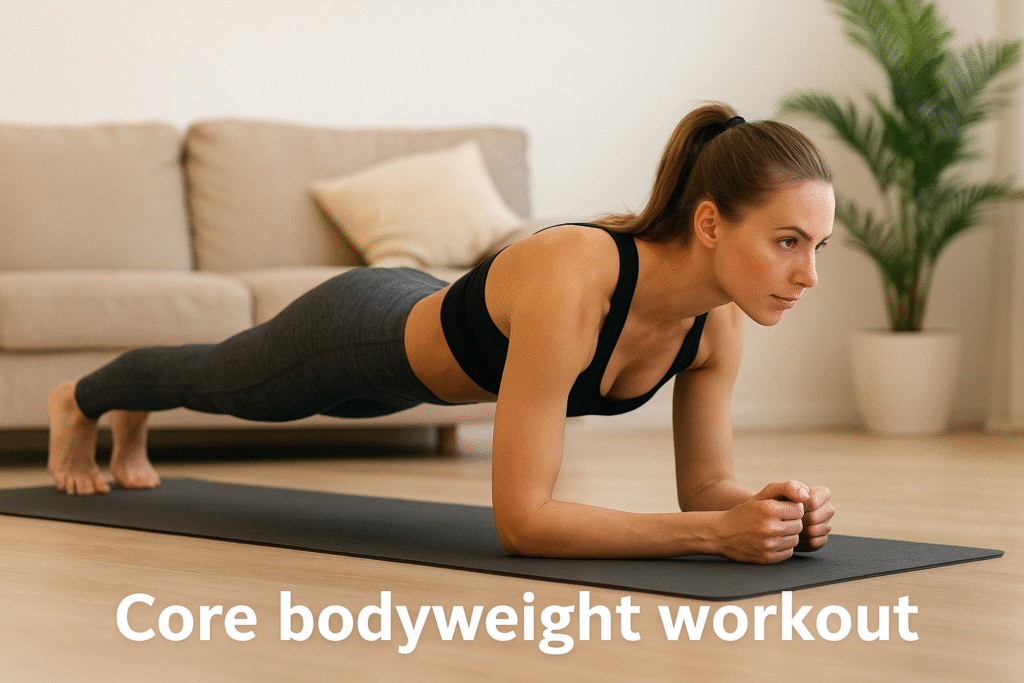
Introduction
If you’re searching for a simple yet powerful way to strengthen your abs, obliques, and lower back—without any equipment—then a core bodyweight workout is your best bet. This form of training builds real-world strength, improves posture, and enhances your athletic performance. The best part? You can complete the entire session in under 15 minutes, anytime and anywhere.
Unlike isolated ab exercises, a core bodyweight workout engages multiple muscle groups simultaneously. It challenges your stability, coordination, and endurance—all key for daily movement and sports performance. Let’s dive into how this quick and effective workout can transform your core strength and overall fitness.
Why Core Workouts Matter
Your core isn’t just your abs—it’s your body’s central powerhouse. It includes muscles in your abdomen, lower back, hips, and pelvis. Together, these muscles stabilize your spine and connect your upper and lower body, allowing efficient movement.
Here’s why a strong core matters:
- Better posture: A solid core supports your spine, reducing slouching and lower back strain.
- Improved balance and stability: Core strength helps maintain control during movement, essential for athletes and everyday activities alike.
- Injury prevention: A weak core increases the risk of back pain and poor body mechanics.
- Enhanced performance: From running to lifting, nearly every motion begins with your core.
Building your foundation with consistent core bodyweight workouts gives you lasting strength and endurance without relying on machines or gym memberships.
Benefits of Core Bodyweight Training
A core workout without equipment offers multiple benefits for fitness enthusiasts of all levels. It’s simple, scalable, and effective.
1. No Equipment, Minimal Space
All you need is your body. These workouts can be done in your bedroom, hotel room, or even outdoors. Perfect for anyone short on time or space.
2. Functional Strength and Endurance
Bodyweight exercises engage stabilizer muscles that are often neglected by machine-based workouts. This helps improve mobility, coordination, and functional strength.
3. Fat Burning and Muscle Definition
Dynamic movements such as mountain climbers and plank variations elevate your heart rate, helping you burn calories while toning your abs.
4. Core Activation and Stability
By using your body as resistance, you strengthen deep core muscles like the transverse abdominis and multifidus—essential for spinal support and stability.
5. Versatility and Progression
You can easily modify exercises for your level. For beginners, start slow. For advanced athletes, increase duration or add isometric holds.
Quick 2-Minute Warm-Up
Before diving into your core bodyweight workout, a short warm-up helps loosen muscles and improve mobility.
| Exercise | Duration | Purpose |
|---|---|---|
| Arm Circles | 30 seconds | Loosen shoulders and upper body |
| Standing Twists | 30 seconds | Activate obliques and spine |
| Cat-Cow Stretch | 1 minute | Warm up spine and core |
Keep your movements controlled and fluid. This prepares your body for optimal performance while reducing the risk of injury.
10-Minute Core Bodyweight Workout Routine
This no equipment core workout targets your entire midsection. Perform each exercise in sequence, rest for 30 seconds between rounds, and complete 2–3 rounds depending on your fitness level.
1. Plank Hold (1 Minute)
- Get into a forearm plank position.
- Engage your abs, glutes, and legs.
- Keep your back straight and avoid sagging hips.
Benefits: Strengthens deep core muscles and improves stability.
2. Bicycle Crunches (45 Seconds)
- Lie on your back, hands behind your head.
- Bring one knee toward your chest while twisting your opposite elbow to meet it.
- Alternate sides rhythmically.
Benefits: Engages obliques and enhances coordination.
3. Mountain Climbers (1 Minute)
- Start in a plank position.
- Drive your knees toward your chest alternately as fast as possible.
Benefits: Boosts endurance and core activation while increasing heart rate.
4. Leg Raises (45 Seconds)
- Lie flat on your back with legs extended.
- Raise your legs until they’re perpendicular to the floor.
- Lower them slowly without touching the ground.
Benefits: Strengthens lower abs and hip flexors.
5. Side Plank (30 Seconds Each Side)
- Lie on your side with one forearm on the floor.
- Lift your hips to form a straight line from shoulders to ankles.
Benefits: Targets obliques and stabilizing muscles.
Tip: Rest 30–45 seconds between exercises. Complete 2–3 rounds for best results.
Cool-Down and Stretch (3 Minutes)
Post-workout stretches aid recovery and flexibility. Spend 3 minutes cooling down to relax your muscles and lower your heart rate.
1. Child’s Pose
- Sit back on your heels, stretch your arms forward, and lower your chest.
Benefit: Relieves lower back tension.
2. Seated Forward Fold
- Sit with legs extended, reach for your toes, and hold the position.
Benefit: Stretches hamstrings and spine.
3. Deep Breathing
- Sit upright, inhale deeply through your nose, and exhale slowly.
Benefit: Promotes relaxation and resets your nervous system.
Tips for Faster Core Results
To see visible results and stronger abs, consistency is key. Here are proven strategies to enhance your progress.
- Train 3–4 times per week.
Regular sessions strengthen endurance and core tone. - Prioritize nutrition.
Eat high-protein meals to build muscle and support recovery. Reduce processed foods and excess sugar. - Stay hydrated.
Water supports energy, digestion, and muscle performance. - Sleep 7–8 hours nightly.
Recovery happens during rest, not just training. - Combine with full-body or HIIT workouts.
Mixing your core bodyweight workout with cardio accelerates fat burning and core definition. - Track your progress.
Record duration, reps, and improvements weekly to stay motivated.
Core workouts are simple, yet they can completely change your fitness level. They build strength, balance, and endurance. Moreover, they help you move better in daily life. Unlike heavy gym routines, bodyweight exercises need no equipment. You can do them anywhere. However, to get the best results, you must stay consistent.
A strong core supports almost every movement you make. For example, it protects your back and improves your posture. Therefore, if you sit for long hours, training your core is vital. In addition, it enhances your performance in other workouts. Whether you run, lift weights, or swim, a powerful midsection helps you move more efficiently.
To begin, focus on simple moves such as planks, bicycle crunches, and leg raises. These exercises engage your abs, obliques, and lower back together. As a result, you gain both strength and stability. Still, remember to warm up first. Gentle stretches like the Cat-Cow pose or standing twists prepare your muscles and reduce injury risk.
Finally, be patient. Core strength grows over time. Celebrate small wins, and stay committed. Soon, your posture, confidence, and endurance will improve naturally.
Sample Weekly Core Plan
| Day | Workout Focus | Duration |
|---|---|---|
| Monday | Core Strength + Plank Series | 15 mins |
| Tuesday | Active Rest (Walking or Yoga) | 20 mins |
| Wednesday | Full-Body HIIT + Core Finishers | 25 mins |
| Thursday | Mobility and Stretch | 10 mins |
| Friday | Core Endurance Circuit | 15 mins |
| Saturday | Optional Bonus Round | 10 mins |
| Sunday | Rest | — |
This plan ensures balance between intensity, recovery, and progression.
Common Mistakes to Avoid
- Holding breath: Always breathe steadily during exercises.
- Arching your back: Maintain spinal alignment to avoid strain.
- Rushing movements: Focus on controlled, deliberate form.
- Skipping warm-up or cooldown: Leads to stiffness and slower recovery.
Proper form ensures maximum benefit from every repetition.
FAQs About Core Bodyweight Workouts
1. How often should I do a core bodyweight workout?
Aim for 3–4 sessions per week, giving your muscles at least one rest day between intense workouts.
2. Can I do this workout every day?
Yes, if you alternate intensity levels and focus on different movements to avoid overtraining.
3. Do I need equipment for effective abs training?
No. Your body provides enough resistance to build strength and stability effectively.
4. How long does it take to see results?
Visible core definition typically appears within 4–6 weeks of consistent training and proper nutrition.
5. Can beginners try this workout?
Absolutely. Modify the duration or reduce rounds to match your fitness level.
6. What should I eat to enhance core results?
Focus on lean protein, complex carbs, and healthy fats. Avoid high-sugar foods and excessive alcohol.
Call-to-Action and Related Workouts
For faster results and variety, explore more bodyweight training guides:
- Best Home Workouts for Weight Loss: Burn Fat Fast Without Equipment
- Full Body HIIT Workout at Home: Burn Fat and Build Strength Fast
Consistency, proper nutrition, and recovery are the key ingredients to achieving a strong, stable, and defined core.
Conclusion
A core bodyweight workout is the most efficient way to strengthen your abs, improve balance, and enhance athletic performance—without the need for equipment or gym access. In just 10–15 minutes a day, you can build stability, endurance, and confidence.
Start small, stay consistent, and focus on form. Your core is the foundation of every movement—train it right, and everything else becomes easier.

